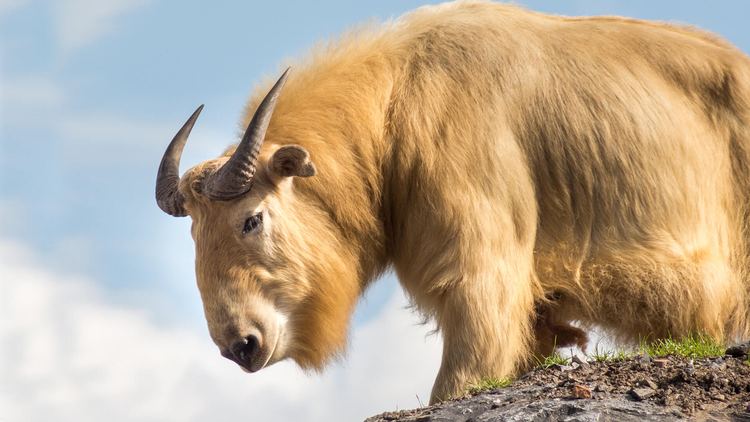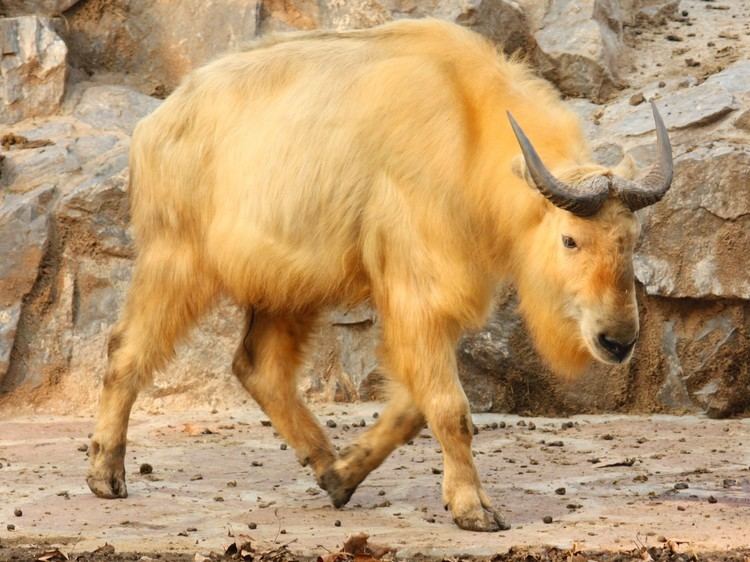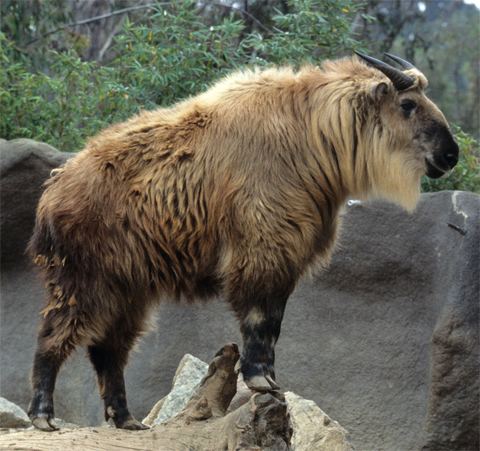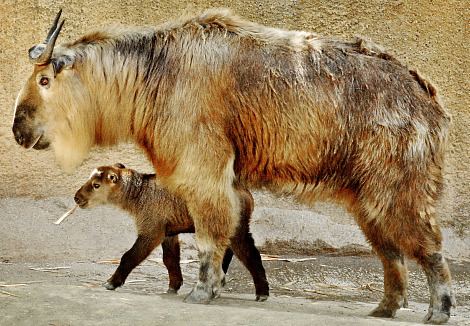Order Artiodactyla Scientific name Budorcas taxicolor Rank Species | Phylum Chordata Genus BudorcasHodgson, 1850 Higher classification Budorcas | |
 | ||
Similar Mammal, Golden takin, Goral, Markhor, Caprinae | ||
Takin bhutan s national animal
The takin (/ˈtɑːkɪn/; Budorcas taxicolor; Tibetan: ར་རྒྱ་, Wylie: ra rgya), also called cattle chamois or gnu goat, is a goat-antelope found in the eastern Himalayas. The four subspecies are: B. t. taxicolor, the Mishmi takin; B. t. bedfordi, the Shaanxi takin or golden takin; B. t. tibetana, the Tibetan or Sichuan takin; and B. t. whitei, the Bhutan takin. Whilst the takin has in the past been placed together with the muskox in the tribe Ovibovini, more recent mitochondrial research shows a closer relationship to Ovis (sheep). Its physical similarity to the muskox is therefore an example of convergent evolution. The takin is the national animal of Bhutan.
Contents
- Takin bhutan s national animal
- Strange animal at edmonton zoo takin
- Appearance
- Habitat
- Biology
- Status
- References

Strange animal at edmonton zoo takin
Appearance

The takin rivals the muskox as the largest and stockiest of the subfamily Caprinae, which includes all goats, sheep, and similar species. Short legs are supported on large, two-toed hooves, which have a highly developed spur. The body is stocky and the chest is deep. The large head is made more distinctive by the long, arched nose, and stout horns that are ridged at the base and can reach 64 cm (25 in) in length. Both sexes have small horns which run parallel to the skull and then turn upwards in a short point, these are around 30 cm (12 in) long. The long, shaggy coat is light in color, with a dark stripe along the back, and males (bulls) also have dark faces. Four subspecies of takin are currently recognised, and these tend to show a variation in coat color. Their thick wool often turns black in color on their undersides and legs. The overall coloration ranges from dark blackish to reddish-brown suffused with grayish-yellow in the eastern Himalayas to lighter yellow-gray in the Sichuan Province to mostly golden or (rarely) creamy-white with fewer black hairs in the Shaanxi Province. The legend of the 'golden fleece', searched for by Jason and the Argonauts, may have been inspired by the lustrous coat of the golden takin (B. t. bedfordi). The hairs of the species can range from 3 cm (1.2 in), on the flanks of the body in summer, up to 24 cm (9.4 in), on the underside of the head in winter.

Takin stand 97 to 140 cm (38 to 55 in) at the shoulder and measure a relatively short 160–220 cm (63–87 in) in head-and-body length. The tail adds only a further 12 to 21.6 cm (4.7 to 8.5 in). Weights reported are somewhat variable, but the species is quite heavy. According to most reports, the males are slightly larger, reportedly weighing 300–350 kg (660–770 lb) against 250–300 kg (550–660 lb) in females. However, per Betham (1908), females are larger, with the largest captive takin known to the author, at 322 kg (710 lb), having been female. Other sources report that takin can weigh up to 400 kg (880 lb) or 600 kg (1,300 lb) in some cases.

Rather than localised scent glands, the takin has an oily, strong-smelling substance secreted over the whole body. This is likely the reason for the swollen appearance of the face. Due to this feature, biologist George Schaller likened the takin to a "bee-stung moose",. Their combination of features has also earned them the nicknames "cattle chamois" and "gnu goat".
Habitat

Takin are found from forested valleys to rocky, grass-covered alpine zones, at altitudes between 1,000 and 4,500 m above sea level. The Mishmi takin occurs in eastern Arunachal Pradesh, while the Bhutan takin is in western Arunachal Pradesh and Bhutan. Dihang-Dibang Biosphere Reserve in Arunachal Pradesh is a stronghold of both Mishmi, Upper Siang (Kopu) and Bhutan takins. The largest actively breeding herd of Takin in North America can be found at the Wilds in Cumberland, Ohio. They are part of a Species Survival Plan (SSP) through the Association of Zoos and Aquariums. A captive population also exists at Minnesota Zoo in the United States. There is also a group of takin on display at the San Diego Zoo and the Roger Williams Park Zoo in Rhode Island.
Biology

Takin are found in small family groups of around 20 individuals, although older males may lead more solitary existences. In the summer, herds of up to 300 individuals gather high on the mountain slopes. Groups often appear to occur in largest numbers when favorable feeding sites, salt licks, or hot springs are located. Mating takes place in July and August. Adult males compete for dominance by sparring head-to-head with opponents, and both sexes appear to use the scent of their own urine to indicate dominance. A single young is born after a gestation period of around eight months. Takin migrate from the upper pasture to lower, more forested areas in winter and favor sunny spots upon sunrise. When disturbed, individuals give a 'cough' alarm call and the herd retreats into thick bamboo thickets and lies on the ground for camouflage.
Takin feed in the early morning and late afternoon, grazing on a variety of leaves and grasses, as well as bamboo shoots and flowers. They have been observed standing on their hind legs to feed on leaves over 3.1 m (10 ft) high. Salt is also an important part of their diets, and groups may stay at a mineral deposit for several days.
They overlap in range with multiple potential natural predators including the Asiatic black bear and the leopard, and (more seldomly) tigers, gray wolves, snow leopards, and dholes. Anecdotally, both bears and wolves have been reported to prey on takin when they can, which is likely given the opportunistic nature of those predators. However, the only confirmed natural predator of takin is the snow leopard, although mature adults may be exempted from regular predation (due to their size) from that predator. The main predator of takin are humans, who hunt them usually for meat (considered delicious by local people), though secondarily for their pelts. Humans have long since exploited takin's fondness for salt licks, where they are easily cornered and killed. Takin are likely still occasionally killed.
Status
Largely due to overhunting and the destruction of their natural habitat, takin are considered Endangered in China and Vulnerable per the IUCN. Though they are not a common species naturally, their numbers appear to have been reduced considerably.
